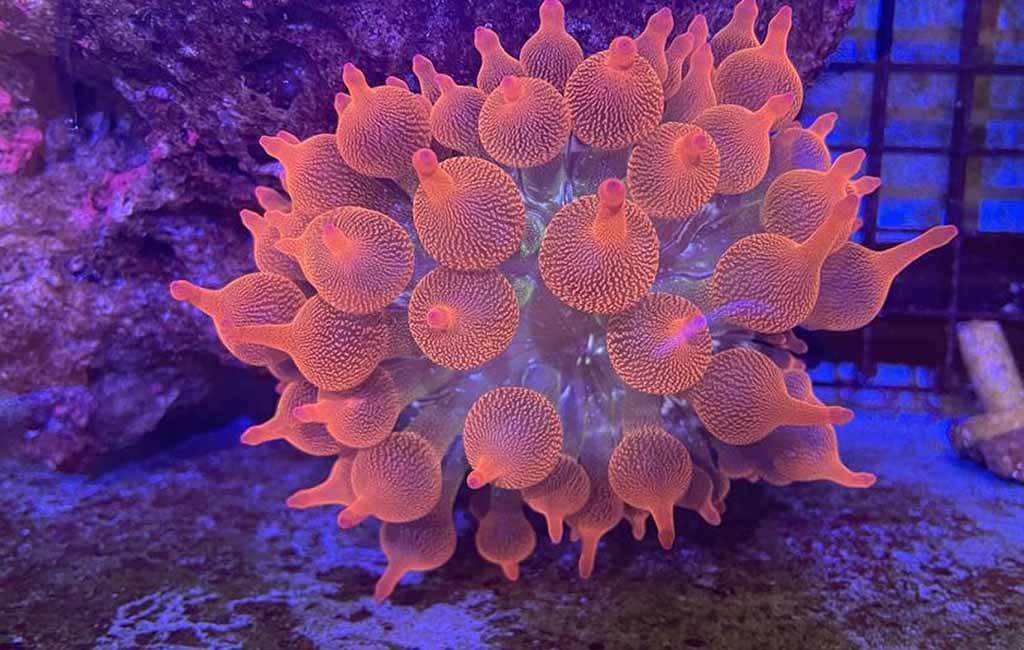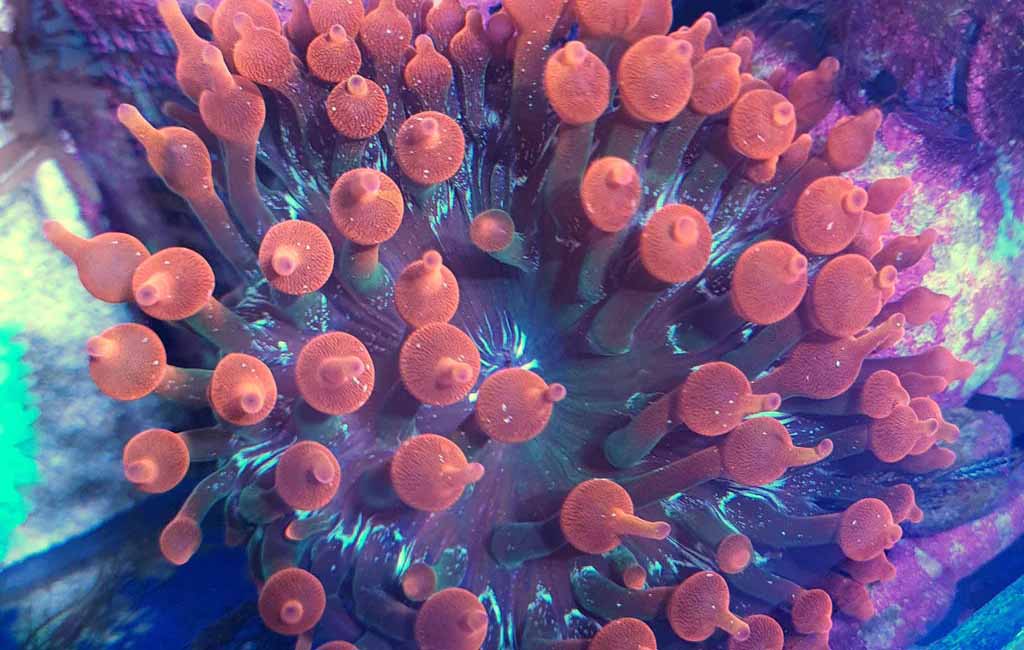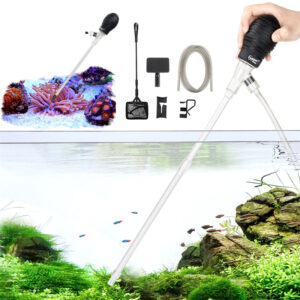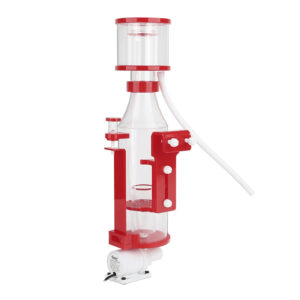Bubble Tip Anemones are unique aquatic living beings. They have several peculiarities. Aquarists love to keep them in their reef tanks as they create a scenic view. However, several aspects are required to keep a bubble tip anemone in a reef tank, i.e., bubble tip anemone care, how to improve bubble tip anemone color, etc. All these aspects are part of the following discussion about their symbiotic relationship with clownfish. Scroll down to learn these things.
Content Table
Bubble Tip Anemone in Reef Tank
Bubble tip anemones have numerous peculiarities. Some of them are as follows.
- They are carnivores and have no central brain. Their body wall has a simple nervous network to function and move properly.
- Bubble tip anemones have bulbous tentacles with a hint of color on their tips.
- They have a symbiotic relationship with Zooxanthellae algae. These algae live in their tissues.
- Other than algae, they also have a symbiotic relationship with clownfish. Clownfish provide food and cleanliness. In return, they provide protection.
- They can regenerate even with the help of a single tissue fragment.
- They can regenerate asexually. To do so, they cut in half or less than that, and they are good to go.
- Bubble-tip anemones attach their feet to rocks, glass, or any hard surface in the tank.
- They are mobile. They move toward the spot where they find optimal water flow and lighting.
- Bubble-tip anemones help to clean the water column as they absorb nutrients and waste from the water.
- They have venomous cells and use these cells to prey.

bubble tip anemone in a reef tank
Are Bubble Tip Anemones Easy to Keep
Yes, Bubble tip anemones are easy to keep and maintain in captivity. Their behavior and temperaments are as follows.
General Behavior in Captivity
- Generally, they keep on finding the perfect spot. Until they locate it, they keep on moving. However, exaggerated movement is also a stress indicator that may be caused due to poor water conditions, lighting issues, or high flow rates.
- During the daytime, they expand and shrink during night or stressful hours.
- They develop stringy tentacles in captivity.
Temperament
- They have a semi-aggressive nature. They stung the long-interested, slow-moving tank mates, corals, and other invertebrates.
- Other than clownfish, fish avoid getting closer to avoid being stung or becoming their food.
- They keep on moving to find the perfect spot. If someone tries to intervene in their territory, the guest will see the aggression.
How to Improve the Coloration of Bubble Tip Anemone?
The bubble tip anemone coloration is due to zooxanthellae algae. Intense or vibrant coloration indicates that the plant is in good condition. Moreover, vibrant coloration helps to elevate the aesthetics of the entire tank. Here are some ways that you can use to improve the coloration.
Lighting
Set moderate to high lighting conditions, i.e., 150–250 PAR in the tank. Zooxanthellae algae require this level for optimal growth. You can achieve this by using blue LEDs or artificial lights.
Water parameters
Maintain the optimal water parameters in your tank. pH, temperature, alkalinity, nitrate, and phosphate are crucial and never-overlooked parameters. Do regular water changes and remove waste from the tank.
Feeding
They mostly get their nutrient portion from photosynthesis. However, feeding is also necessary, but feed them occasionally. You can feed them on small meaty food items, i.e., brine shrimps, mysis shrimps, etc.
Flow Rate
Use a moderate flow rate to optimize coloration. High flow rates can cause stress, resulting in low or dull coloration.

Care bubble tip anemone
Bubble Tip Anemone Care Guide
Tank Requirement
Tank size
Take at least a 30-gallon tank. It should be high enough to accommodate because bubble-tip anemones can grow up to 1 foot high. However, try to use a large tank to improve and ensure stability.
Substrate
Use live rock as a substrate. If they have crevices, they will further improve the attachment. However, avoid using sand as it can’t attach to it.
Flow Rate
Ensure a random, moderate flow rate. However, avoid a higher flow rate as it can cause stress that results in discoloration.
Lighting
Lighting is very crucial as it plays a vital role in their optimal growth. Use moderate to highlight. Blue LEDs, T5, Metal Halides, etc., can help you to achieve this level. But it is recommended to install a professional saltwater aquarium light.
Placement
Place the tank on a sturdy and level surface or tank stand.
Water Parameters
| Parameter | Value |
| Temperature | 72-82°F |
| pH | 8.1-8.4 |
| Salinity | 1.023-1.025 |
| Alkalinity | 8-12 dKH |
| Calcium | 400-450 ppm |
| Nitrate | < 5-10 ppm |
| Phosphate | < 0.05 ppm |
Feeding
Bubble-tip anemones derive most of their energy from photosynthesis. Therefore, they don’t heavily require traditional food items. However, it is necessary to feed them once or twice a week. You can go with chopped shrimps, mysis shrimps, silversides, marine pellets, etc. Avoid overfeeding, as overfeeding can cause water pollution and other problems in the anemone’s tank.
Tank Mates
They have a symbiotic relationship with clownfish species. You can keep Maroon, Percula, and Ocellaris clownfish species in the tank. However, avoid hosting them with nipping fish or invertebrates, i.e., butterfly fish, angelfish, etc. Moreover, slow-moving species, i.e., snails, are also not suitable.
Health Condition
You can understand the health conditions of the bubble tip anemone with the following parameters.
Healthy Bubble Tip Anemone
- Vibrant coloration
- Occasional moment
- Sticky tentacles
- Fully expands during daytime hours

Improve the bubble tip anemone color
Best Clownfish for Bubble Tip Anemone
Clownfish have a symbiotic relationship with bubble tip anemone, i.e., mutualism. Several clownfish species can go well with them. However, here are some of the top choices for your tank.
Maroon Clownfish are considered the most suitable fish as they readily adapt to the environment. However, you need to be careful as they can become aggressive, and the results can be harmful.
| Tomato Clownfish | Fire Clownfish | Cinnamon Clownfish | Clarkii Clownfish |
Closing Remarks
Bubble tip anemones are among the unique living beings with several peculiarities, i.e., no central brain and structure, symbiotic relationship, etc. Although they are hardy, they have some challenges, i.e., aggression, territorial behavior, etc. Proper feeding, adequate lighting and moderate flow rate, and optimal water parameters help to improve their coalition. Optimize your tank look by keeping the bubble tip anemone in a reef tank with clownfish.


Leave a comment